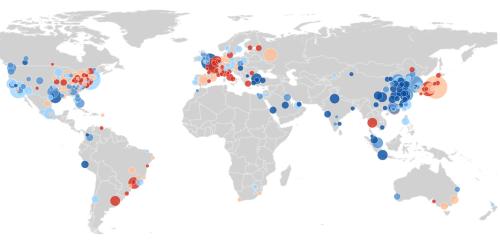METRO MONITOR
An index of inclusive economic growth in the 100 largest U.S. metropolitan areas
As 2017 begins, the economy is, by most conventional measures, in remarkable condition. After years of slow but steady recovery following the Great Recession, the United States is currently poised to continue one of its longest economic expansions on record. The nation has added jobs and output faster than most advanced economies since the recession, the unemployment rate has fallen to near its pre-recession level, and middle-class wage growth is gaining momentum.
So why do so many Americans seem anxious about the direction of the economy? Last year’s election laid bare the frustration of millions of voters who seem to feel left behind by the quickening pace of economic change. Though the forces of trade and technological innovation continue to propel the economy forward, they have also led to tectonic shifts that make it harder for communities large and small to produce inclusive growth and prosperity that delivers economic security and opportunity for all.
Today, leaders at the national and local levels are responding to these economic and social challenges with renewed urgency. In metropolitan areas—the engines of the U.S. economy—coalitions of political, civic, and business leaders are implementing policies and strategies that support the ability of firms and industries to compete and grow in a global economy. At the same time, these leaders are investing in new strategies to ensure that growth delivers tangible results for workers, families, and communities.
The Metro Monitor aims to inform the efforts of these leaders by tracking economic progress in the nation’s 100 largest metropolitan areas along three dimensions: growth, prosperity, and inclusion. This year’s edition of the Metro Monitor focuses on trends from 2010 to 2015, a period of hastening recovery from the Great Recession. It reveals considerable variation in how different metro areas fared. Specifically:
- Growth was widespread among large metropolitan areas from 2010 to 2015. Metro areas in Florida, California, and the Carolinas ranked among the fastest-growing job markets, as the Sunbelt made a strong comeback from the recession. Many Sunbelt metro areas also saw large increases in employment at young firms. Research- and technology-intensive advanced industries powered growth in gross metropolitan product (GMP) during this portion of the recovery, benefiting places like San Jose, Austin, Houston, Seattle, and Nashville. Post-industrial metro economies around the Great Lakes saw far more modest growth, however. These trends may indicate that large metro areas are returning to their pre-recession growth trajectories, for better and worse.
- Large metropolitan areas and the country as a whole made uneven progress on prosperity from 2010 to 2015. Productivity, or total economic output per job, rose in only 45 of the 100 largest metro areas. Productivity grew fastest in regions that specialize in research- and technology-intensive industries, but declined in metro areas where the retail and hospitality sectors drove growth. Meanwhile, average wages grew in most large metro areas from 2010 to 2015 as unemployment rates dropped. Average wage growth outpaced productivity growth in most large metro areas, including those in which productivity declined. Standards of living also rose in most large metro areas as GMP growth outpaced population growth.
- Inclusion outcomes improved in many metropolitan areas from 2010 to 2015 as hiring accelerated. However, outcomes remained below their pre-recession levels in most large metro areas. Employment rates improved in 95 metro areas as faster hiring created job opportunities for more people. Rates of relative income poverty fell in 72 large metro areas as wages in the bottom half of the income distribution improved. Median wages rose in only a little more than half of large metro areas, however, mostly because of dramatic increases from 2014 to 2015. These outcomes also varied considerably for workers with different levels of education and racial/ethnic backgrounds, both across and within metro areas.
- Only 14 of the 100 largest metropolitan areas did better than the average of their peers on growth, prosperity, and inclusion from 2010 to 2015. Knowledge- and research-intensive advanced services industries played a big role in the success of these consistently high-performing metro areas, suggesting innovation and technology can help generate inclusive growth and prosperity. A smaller number of metro areas posted modest gains in these categories despite not achieving consistent above-average performance. Meanwhile, 23 of the 100 largest metro areas performed worse than the average of their peers across growth, prosperity, and inclusion. They included places in the Northeast, Midwest, and South with slower-growing industries, and Sunbelt places hit especially hard by the housing bust of the late 2000s.
Despite improving economic conditions during the 2010 to 2015 period, most metro areas still face gaps between headline growth and bottom-line prosperity and inclusion. For many, a full recovery from the Great Recession remained out of reach. The economic trends of this period suggest that if leaders wish to sustain support for policies that support growth, those policies must incorporate deliberate efforts to ensure that more people, businesses, and communities are able to share in the benefits of economic growth and prosperity.
Download the executive summary
The Brookings Institution is committed to quality, independence, and impact.
We are supported by a diverse array of funders. In line with our values and policies, each Brookings publication represents the sole views of its author(s).







